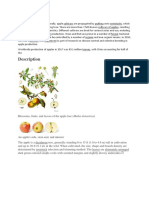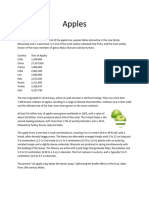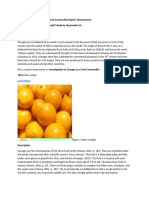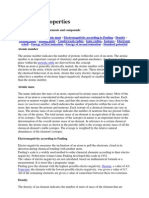Fruit Citrus × Family Rutaceae Bitter Orange Hybrid Pomelo Mandarin
Fruit Citrus × Family Rutaceae Bitter Orange Hybrid Pomelo Mandarin
Uploaded by
Pei LingCopyright:
Available Formats
Fruit Citrus × Family Rutaceae Bitter Orange Hybrid Pomelo Mandarin
Fruit Citrus × Family Rutaceae Bitter Orange Hybrid Pomelo Mandarin
Uploaded by
Pei LingOriginal Description:
Original Title
Copyright
Available Formats
Share this document
Did you find this document useful?
Is this content inappropriate?
Copyright:
Available Formats
Fruit Citrus × Family Rutaceae Bitter Orange Hybrid Pomelo Mandarin
Fruit Citrus × Family Rutaceae Bitter Orange Hybrid Pomelo Mandarin
Uploaded by
Pei LingCopyright:
Available Formats
The orange (specifically, the sweet orange) is the fruit of the citrus species Citrus sinensis in
the family Rutaceae.[2] The fruit of the Citrus sinensis is considered a sweet orange, whereas the
fruit of the Citrus aurantium is considered a bitter orange. The orange is a hybrid, possibly
between pomelo (Citrus maxima) and mandarin (Citrus reticulata), which has been cultivated
since ancient times.[3]
Oranges in Florida.
As of 1987, orange trees were found to be the most cultivated fruit tree in the world.[4] Orange
trees are widely grown in tropical and subtropical climates for their sweet fruit. The fruit of the
orange tree can be eaten fresh, or processed for its juice or fragrant peel. [5] As of 2012, sweet
oranges accounted for approximately 70% of citrus production.[6] In 2010, 68.3 million metric tons
of oranges were grown worldwide, production being particularly prevalent in Brazil and the U.S.
states of Florida[7]and California.[8]
Different names have been given to the many varieties of the genus. Orange applies primarily to
the sweet orange Citrus sinensis (L.)Osbeck. The orange tree is an evergreen, flowering tree,
with an average height of 9 to 10 m (30 to 33 ft), although some very old specimens can reach
15 m (49 ft).[12] Its oval leaves, alternately arranged, are 4 to 10 cm (1.6 to 3.9 in) long and
have crenulatemargins.[13] Although the sweet orange presents different sizes and shapes varying
from spherical to oblong, it generally has ten segments (carpels) inside, and contains up to six
seeds (or pips)[14] and a porous white tissue called pith or, more properly, mesocarp or albedo
lines its rind.[15] When unripe, the fruit is green. The grainy irregular rind of the ripe fruit can range
from bright orange to yellow-orange, but frequently retains green patches or, under warm climate
conditions, remains entirely green. Like all other citrus fruits, the sweet orange is non-climacteric.
The Citrus sinensis is subdivided into four classes with distinct characteristics: common oranges,
blood or pigmented oranges, navel oranges, and acidless oranges. [16][17][18]
You might also like
- Orange Juice PlantDocument322 pagesOrange Juice Plantkatamani templeNo ratings yet
- Apple TreeDocument4 pagesApple TreeIoana GrayNo ratings yet
- Citrus CultivationDocument16 pagesCitrus Cultivationbhagirathchoudhari51710% (1)
- Orange Botanical Information and TerminologyDocument1 pageOrange Botanical Information and TerminologyBrianNo ratings yet
- OrangeDocument15 pagesOrangesujithas100% (1)
- OrangeDocument23 pagesOrangefisher391No ratings yet
- Orange: Riska Nur Fadila Xiips3Document2 pagesOrange: Riska Nur Fadila Xiips3Fathoni WildanNo ratings yet
- PortocalaDocument19 pagesPortocalaOKMANNo ratings yet
- Real WorldDocument3 pagesReal WorldbryanpieperNo ratings yet
- Orange, To Distinguish It From The Related Citrus × Aurantium, Referred To AsDocument1 pageOrange, To Distinguish It From The Related Citrus × Aurantium, Referred To AsVinod NairNo ratings yet
- Orange: Citrus × SinensisDocument1 pageOrange: Citrus × SinensisMabel YungNo ratings yet
- The Miracle of Lemons: Practical Tips for Health, Home and BeautyFrom EverandThe Miracle of Lemons: Practical Tips for Health, Home and BeautyRating: 4 out of 5 stars4/5 (2)
- Document 1Document2 pagesDocument 1Ngọc NguyễnNo ratings yet
- Ass 2Document5 pagesAss 2Beverly S. PurisimaNo ratings yet
- Fruit Citrus Family RutaceaeDocument1 pageFruit Citrus Family Rutaceaeriturai351No ratings yet
- Orange FruitDocument2 pagesOrange FruitcrystalNo ratings yet
- Taste of MangoDocument2 pagesTaste of Mangokaru320No ratings yet
- Apple: For The Technology Company, See For Other Uses, See - "Apple Tree" Redirects Here. For Other Uses, SeeDocument5 pagesApple: For The Technology Company, See For Other Uses, See - "Apple Tree" Redirects Here. For Other Uses, SeelathaprabhuNo ratings yet
- ISSN 2230 - 8407: Meena Ajay K Et Al. IRJP 2 (1) 2011 14-19Document6 pagesISSN 2230 - 8407: Meena Ajay K Et Al. IRJP 2 (1) 2011 14-19Samra GurjeetNo ratings yet
- Botanical Apple StudiesDocument1 pageBotanical Apple Studiesvivajutiapa25No ratings yet
- Citrus Fruits: Citrus Is A Common Term and Genus of Flowering Plants in The Family RutaceaeDocument4 pagesCitrus Fruits: Citrus Is A Common Term and Genus of Flowering Plants in The Family RutaceaeBabu NagarajanNo ratings yet
- The Plant of MonsteraDocument3 pagesThe Plant of MonsteraWaytoo SeriousNo ratings yet
- Report TextDocument1 pageReport TextBrilian SetiaNo ratings yet
- CitrusDocument5 pagesCitrusJrPelayoNo ratings yet
- Bloom Plant 0807Document1 pageBloom Plant 0807Nyimas HoirunisaNo ratings yet
- Citrullus Lanatus: Elliptical-Shaped Fruits and Vegetables WatermelonDocument3 pagesCitrullus Lanatus: Elliptical-Shaped Fruits and Vegetables WatermelonJel De Los ReyesNo ratings yet
- Tree Azadirachta Indica NeemDocument7 pagesTree Azadirachta Indica NeemBasavarajBusnurNo ratings yet
- Orange NotesDocument1 pageOrange NotesAlwyn DsouzaNo ratings yet
- An Article Detailing Miscellaneous Tropical and Subtropical Fruits: Being the Durian, Santol, Carambola, Bilimbi, Tamarind, Carissa, Ramontchi, Ketembilla, Tuna, Pitaya, Tree-Tomato, and Genipa FruitsFrom EverandAn Article Detailing Miscellaneous Tropical and Subtropical Fruits: Being the Durian, Santol, Carambola, Bilimbi, Tamarind, Carissa, Ramontchi, Ketembilla, Tuna, Pitaya, Tree-Tomato, and Genipa FruitsNo ratings yet
- Orange (Fruit) - Wikipedia, The Free EncyclopediaDocument36 pagesOrange (Fruit) - Wikipedia, The Free Encyclopedialucifer_1261994No ratings yet
- Orange (Fruit) - WikipediaDocument28 pagesOrange (Fruit) - WikipediaRohit RajakNo ratings yet
- The Natural Apothecary: Lemons: Tips for Home, Health and BeautyFrom EverandThe Natural Apothecary: Lemons: Tips for Home, Health and BeautyRating: 4.5 out of 5 stars4.5/5 (2)
- Apple - WikipediaDocument28 pagesApple - WikipediafawxesNo ratings yet
- Prut 1Document1 pagePrut 1Kyle BrianNo ratings yet
- Safari - 07-Jun-2020 at 5:25 PM 4Document1 pageSafari - 07-Jun-2020 at 5:25 PM 4Santosh J Yadav's FriendNo ratings yet
- Investigation of Orange As A Food Commodity ReportDocument6 pagesInvestigation of Orange As A Food Commodity ReportEverything ChannelNo ratings yet
- N Orange Is A Type of Citrus Fruit That People Often EatDocument3 pagesN Orange Is A Type of Citrus Fruit That People Often Eatkarina chaswinNo ratings yet
- Mango: Jump To Navigationjump To SearchDocument12 pagesMango: Jump To Navigationjump To SearchVicces P. EstradaNo ratings yet
- Feild Report For Piasi EductaionDocument7 pagesFeild Report For Piasi Eductaionnicholas magalaNo ratings yet
- Moringa OleiferaDocument13 pagesMoringa OleiferaEmcee WaterNo ratings yet
- Malus Malus Sieversii: Apple BlossomDocument1 pageMalus Malus Sieversii: Apple BlossomRaluNo ratings yet
- Mango PDFDocument10 pagesMango PDFDiLer SaLihNo ratings yet
- Sweet PataoDocument1 pageSweet PataoTanvi PawarNo ratings yet
- AppleDocument24 pagesApplesiddharthchoudhary.eisNo ratings yet
- Etymology: PomegranateDocument7 pagesEtymology: Pomegranatenishat.fatimaNo ratings yet
- Assingment-3 Study of Plants: Subject-Landscape Design and Ecological Architecture Course Code - 8ar173Document30 pagesAssingment-3 Study of Plants: Subject-Landscape Design and Ecological Architecture Course Code - 8ar173CHANDAN KUMARNo ratings yet
- Monu Swence JumboDocument5 pagesMonu Swence JumboDeepak RameshNo ratings yet
- Citrus MicrocarpaDocument2 pagesCitrus MicrocarpaWardani NoviNo ratings yet
- Orange (Fruit) - WikipediaDocument22 pagesOrange (Fruit) - WikipediafawxesNo ratings yet
- Pests and Diseases: List of Citrus DiseasesDocument5 pagesPests and Diseases: List of Citrus DiseasesVenkat KrishnanNo ratings yet
- Untitled DocumentDocument3 pagesUntitled Documentmeygipranata65No ratings yet
- An Encyclopedia of Philippine TreesDocument162 pagesAn Encyclopedia of Philippine TreesDerrick Yson (Mangga Han)No ratings yet
- AbstractDocument5 pagesAbstractDeepak VasudevNo ratings yet
- Tomato: NamesDocument27 pagesTomato: NamesToday NewsNo ratings yet
- 2 IntroductionDocument3 pages2 IntroductionshujaNo ratings yet
- Mangifera Mangifera Indica Mangifera FoetidaDocument1 pageMangifera Mangifera Indica Mangifera FoetidaKyle BrianNo ratings yet
- SIP Chapter 2 & 3Document3 pagesSIP Chapter 2 & 3Aoki kazeNo ratings yet
- RosemaryDocument4 pagesRosemaryLito ManayonNo ratings yet
- Leaves Alternate Flowers Petals: Pollen Grain of HibiscusDocument2 pagesLeaves Alternate Flowers Petals: Pollen Grain of HibiscusCress Toral SantillanNo ratings yet
- Semener ReportDocument17 pagesSemener ReportHUSSAINI SANI KANKIANo ratings yet
- Daily Lesson Plan: Teacher'S Name: Michelle Law Pei LingDocument1 pageDaily Lesson Plan: Teacher'S Name: Michelle Law Pei LingPei LingNo ratings yet
- Styles Since World War Two: ServantsDocument2 pagesStyles Since World War Two: ServantsPei LingNo ratings yet
- Lizards Are A Widespread Group Of: Brookesia Micra Sphaerodactylus Ariasae MegalaniaDocument1 pageLizards Are A Widespread Group Of: Brookesia Micra Sphaerodactylus Ariasae MegalaniaPei LingNo ratings yet
- When Waves Enter Shallow Water, They Slow Down and Their Amplitude (Height) IncreasesDocument2 pagesWhen Waves Enter Shallow Water, They Slow Down and Their Amplitude (Height) IncreasesPei LingNo ratings yet
- CuffsDocument4 pagesCuffsPei LingNo ratings yet
- Protests Against Religious FreedomDocument1 pageProtests Against Religious FreedomPei LingNo ratings yet
- CentipedesDocument2 pagesCentipedesPei LingNo ratings yet
- Sea (With The Definite Article) Is The Interconnected System of The Earth'sDocument2 pagesSea (With The Definite Article) Is The Interconnected System of The Earth'sPei LingNo ratings yet
- The Retention of The BasicDocument2 pagesThe Retention of The BasicPei LingNo ratings yet
- Persea Americana, or The Avocado, Is Believed To Have Originated in The State ofDocument1 pagePersea Americana, or The Avocado, Is Believed To Have Originated in The State ofPei LingNo ratings yet
- PolyesterDocument4 pagesPolyesterPei LingNo ratings yet
- Alternative Terms: Eid Al-Fitr (Raya PuasaDocument2 pagesAlternative Terms: Eid Al-Fitr (Raya PuasaPei LingNo ratings yet
- Etymology: Cockroaches AreDocument4 pagesEtymology: Cockroaches ArePei LingNo ratings yet
- Etymology: Butterflies (Superfamily Butterflies (SuperfamilyDocument2 pagesEtymology: Butterflies (Superfamily Butterflies (SuperfamilyPei LingNo ratings yet
- LemongrassDocument2 pagesLemongrassPei LingNo ratings yet
- HistoryDocument1 pageHistoryPei LingNo ratings yet
- Sejarah Pengakap MalaysiaDocument1 pageSejarah Pengakap MalaysiaPei LingNo ratings yet
- Bronze: Pengakap Kanak-Kanak (Cub Scout Lanyard), Which Is Blue in ColourDocument2 pagesBronze: Pengakap Kanak-Kanak (Cub Scout Lanyard), Which Is Blue in ColourPei LingNo ratings yet
- Ampere's Law: L With A Magnetic Field BDocument1 pageAmpere's Law: L With A Magnetic Field BPei LingNo ratings yet
- ChilliDocument2 pagesChilliPei LingNo ratings yet
- Braised Chinese Noodles RecipeDocument1 pageBraised Chinese Noodles RecipePei LingNo ratings yet
- List of Periodic Table Elements Sorted byDocument2 pagesList of Periodic Table Elements Sorted byPei LingNo ratings yet
- Bio Assg EgDocument3 pagesBio Assg EgPei Ling100% (1)
- Chemical Properties: Chemical Properties of Elements and Compounds - Atomic NumberDocument4 pagesChemical Properties: Chemical Properties of Elements and Compounds - Atomic NumberPei LingNo ratings yet
- DividerDocument7 pagesDividerPei LingNo ratings yet




















































































